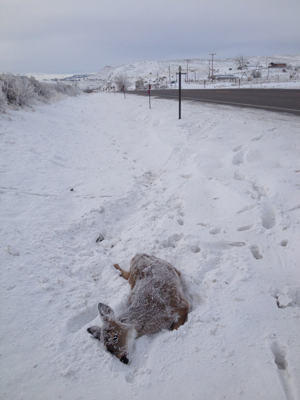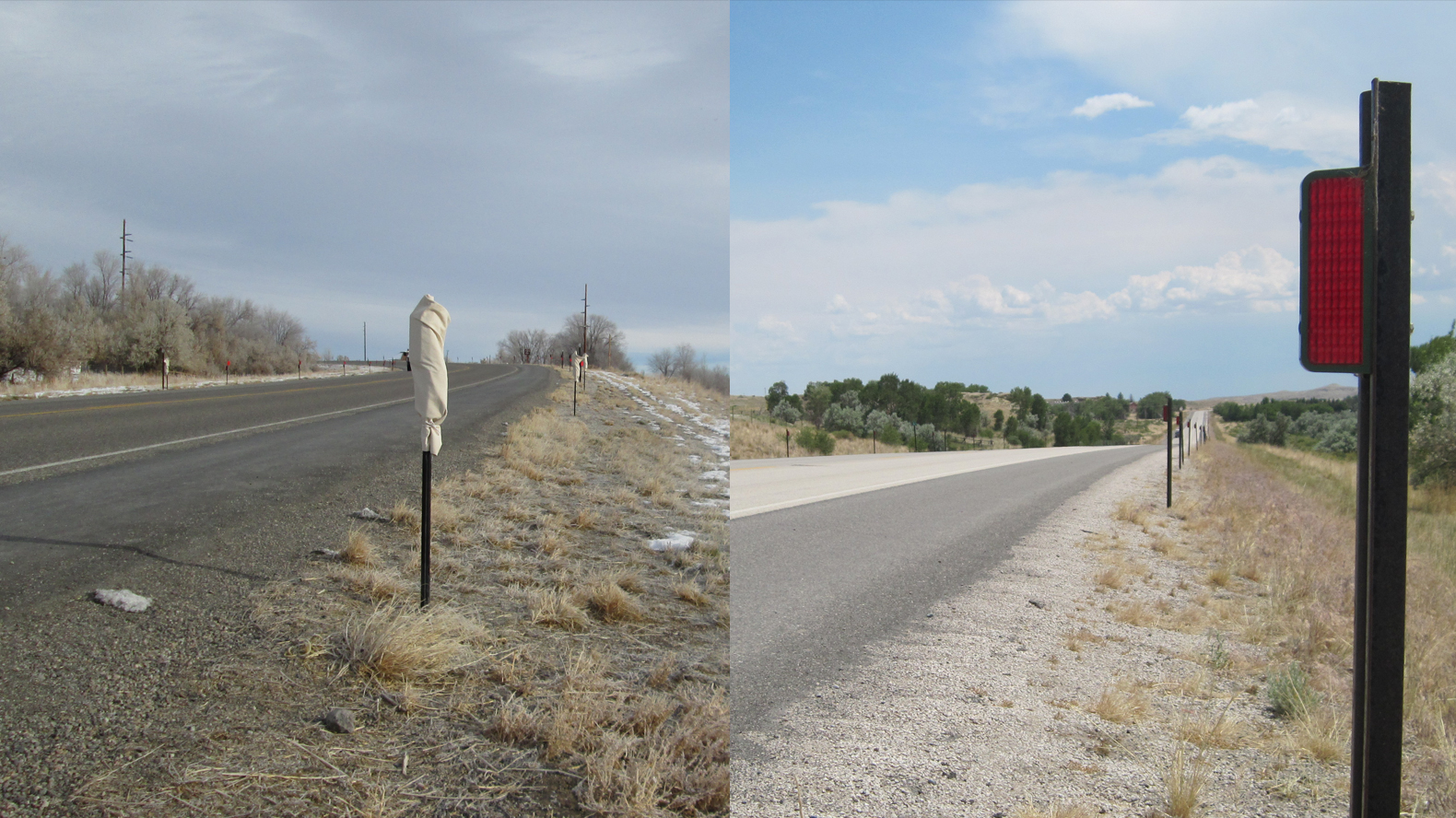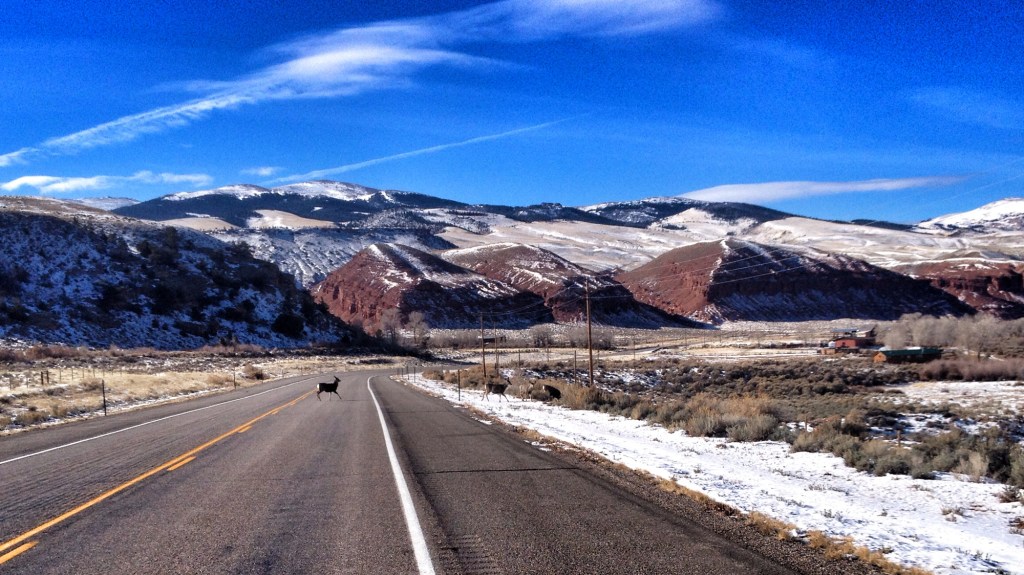Research into the best ways to reduce road deaths of mule deer inadvertently found a new tool that can reduce roadkill: white canvas bags stuck on reflector signs.
These white bags are easy to install and inexpensive. And they may be more effective at allowing deer to cross roads safely than more costly methods.
The study, funded by the Wyoming Department of Transportation, focused on three wildlife-vehicle collision hotspots in Wyoming’s Bighorn Basin. The study was designed to test the effectiveness of wildlife reflectors that are being deployed globally help animals cross roads safely. In the course of testing the reflectors, according to research published in the Wildlife Society Bulletin, researchers found that reflectors covered in white canvas bags as a control were more effective than the actual reflectors.
How Did the Deer Cross the Road?
In the Rocky Mountain West, mule deer and other large mammals still undertake lengthy seasonal migrations from high mountain habitats to lower-elevation sagebrush. The migrations require crossing roads, putting both the animals and drivers at risk.
I live in mule deer country, and every winter see the disturbing carnage along our roads. In many parts of the West, mule deer populations are in decline, and conservationists recognize road deaths as one of the biggest threats. Roads also can cut off migration routes, which can threaten entire populations.
In Wyoming, collisions with deer cause $24 million dollars in damage and injury annually. The economic value of all those dead deer (based on the economic value those deer bring for hunting and wildlife viewing) is another $23 million.

Northcentral Wyoming has an extremely high deer-vehicle collision rate, with some sections of roads averaging 10 to 18 collisions per mile, per year.
When it comes to getting deer (and other wildlife) across the road, the evidence is clear: The most effective methods are wildlife overpasses and underpasses.
“The safest solution for humans and animals are crossing structures that allow animals to cross roads without ever touching the road surface,” says Corinna Riginos, a conservation scientist with The Nature Conservancy in Wyoming, and lead author on the paper.
But such crossing structures are not always feasible. They are expensive, and in some areas geography and development patterns can make them impossible to install.
Testing the Reflector
In areas where wildlife crossing structures aren’t feasible, a number of other methods have been tested. The Wildlife Society Bulletin paper states that many of these – including “deer whistles, olfactory repellents, mirrors, and model deer in alarm posture” – have been proven largely ineffective.
Another method is the use of wildlife-warning reflectors. These reflectors are installed on roadside posts “so that vehicle headlights reflect in a moving pattern both across the road and into the roadside vegetation. The intent is that approaching deer or other ungulates will notice the reflected light and halt or flee away from the road until the vehicle and lights have passed and then cross safely.”
Amidst conflicting studies, conservationists continue to debate the effectiveness of these reflectors. The Wyoming Department of Transportation study sought to determine their effectiveness in areas with high mule deer – vehicle collision rates.
Reflectors were installed along roads. As controls, researchers covered some of the reflectors periodically with white bags and with black bags. The results were surprising. While the reflectors were moderately more effective than those covered with black bags, the white bags were the most effective of all.
In fact, areas with the white bags had 33 percent fewer deer carcass counts than areas with reflectors, and 65 percent fewer carcass counts than areas with the black bags. Essentially, the white bags were serving the same purpose as the reflectors, causing deer to stop or move away from the road. (Researchers also installed video cameras that captured deer reactions). But the white bags, in this study, were found to be more effective.
“We didn’t set out to test the effectiveness of white bags on deer,” says Riginos. “We set out to test the effectiveness of reflectors.”
The white bags are also more cost effective. Wildlife reflectors cost $25 each compared to just $1.50 for a white canvas bag. But Riginos cautions that the bags may not be a long-term solution.
“Will deer get used to the bags and not be as alarmed by them? It’s an open question,” she says. “We don’t know if the benefits of these bags will last.”
Another Tool to Save Mule Deer
Why do the white bags work? The answer can only be conjecture. It may simply be that the flash of white makes a deer pause and pay attention, giving enough time for a car to pass safely. Researchers think the white patch may resemble a deer’s rump patch, which it flashes in alarm. In other words, it’s like flashing a “Danger!” sign to the deer.

Whatever the case, Riginos says that “White bags could add another tool to our toolbox in areas where we can’t install crossing structures. And we need all the tools we can find.”
Compared to the many complex issues facing migratory big game animals, roads are a problem that is comparatively easy to address.
“This is an issue that unites people,” says Riginos. “Mule deer are so important to this state both economically and culturally. We have some of the largest and most intact mammal migrations in the world. Finding solutions not only protects the animals, it keeps people safe. These are truly win-win solutions.”




Resembling skinny humans clothed in white cloth, maybe? Triggering a caution reaction.
Maybe large, white reflectors would combine the benefits of both the reflectors and the white bags.
In the 1980’s I participated in a similar research project sponsored by the Wyoming Game and Fish Department and the University of Wyoming. The project area was Nugget Canyon on Highway 30 between Kemmerer and Cokeville. The project used a red, double reflector, and we expected that to be the best option to prevent deer-vehicle collisions. We also used white canvas bags over certain sections of reflectors as a control area, but they were smaller in size and not bright white. The project produced no substantial recommendations except to fence the highway with elk fence (and decades later, put in an overpass). I’m as surprised as anyone that the white bags were more effective, but knowing the project area and seeing the configuration of the bags, I’d speculate that perhaps the bags flopped in the wind and that spooked the deer. I suspect it will be only temporary as deer will get used to any kind of deterrent including noisemakers like Zon guns.
Since I was ten years old and an animal lover, 60 years ago, I have wondered about the feasibility of sound helping animals on roads.
If animals can hear sound frequencies that humans can’t, why not have cars emit a frequency, ideally beamed out ahead, that alerts animals to the approach of the vehicle.
This, if effective, could be used on trains as well.
If that works, I’ve got a lot more ideas to help the non human creatures of the earth. I stay awake at night contemplating solutions, some of them big and radical but I believe viable and overdue.
Thanks,
Thea Doty
Where can I get 1? Thank you!!
I have read that the biggest problem that the reindeer herders in the Nordic countries have is losing stock
“hit by an automobile”. The reindeer run freely like our deer, etc., but are part of an owner’s herd. It would seem like a good gesture to get the white bag idea over to someone in those countries. I do not have any contacts to offer, however.
I want to know how the white bags work.
I travel highways in Upstate NY, and would love to help.
j victor
One lady suggested that the deer crossing signs be moved so the deer won’t cross the road were it is so busy. Ha Ha!